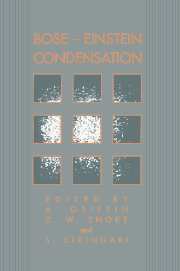Book contents
- Frontmatter
- Contents
- Preface
- Preface to paperback edition
- 1 Introduction: Unifying Themes of Bose–Einstein Condensation
- Part one Review Papers
- Part two Brief Reports
- 20 BEC in Ultra-cold Cesium: Collisional Constraints
- 21 BEC and the Relaxation Explosion in Magnetically Trapped Atomic Hydrogen
- 22 Quest for Kosterlitz–Thouless Transition in Two-Dimensional Atomic Hydrogen
- 23 BEC of Biexcitons in CuCl
- 24 The Influence of Polariton Effects on BEC of Biexcitons
- 25 Light-Induced BEC of Excitons and Biexcitons
- 26 Evolution of a Nonequilibrium Polariton Condensate
- 27 Excitonic Superfluidity in Cu2O
- 28 On the Bose–Einstein Condensation of Excitons: Finite-lifetime Composite Bosons
- 29 Charged Bosons in Quantum Heterostructures
- 30 Evidence for Bipolaronic Bose-liquid and BEC in High-Tc Oxides
- 31 The Dynamic Structure Function of Bose Liquids in the Deep Inelastic Regime
- 32 Possibilities for BEC of Positronium
- 33 Bose–Einstein Condensation and Spin Waves
- 34 Universal Behaviour within the Nozières–Schmitt-Rink Theory
- 35 Bound States and Superfluidity in Strongly Coupled Fermion Systems
- 36 Onset of Superfluidity in Nuclear Matter
- Appendix. BEC 93 Participant List
- Index
29 - Charged Bosons in Quantum Heterostructures
Published online by Cambridge University Press: 15 December 2009
- Frontmatter
- Contents
- Preface
- Preface to paperback edition
- 1 Introduction: Unifying Themes of Bose–Einstein Condensation
- Part one Review Papers
- Part two Brief Reports
- 20 BEC in Ultra-cold Cesium: Collisional Constraints
- 21 BEC and the Relaxation Explosion in Magnetically Trapped Atomic Hydrogen
- 22 Quest for Kosterlitz–Thouless Transition in Two-Dimensional Atomic Hydrogen
- 23 BEC of Biexcitons in CuCl
- 24 The Influence of Polariton Effects on BEC of Biexcitons
- 25 Light-Induced BEC of Excitons and Biexcitons
- 26 Evolution of a Nonequilibrium Polariton Condensate
- 27 Excitonic Superfluidity in Cu2O
- 28 On the Bose–Einstein Condensation of Excitons: Finite-lifetime Composite Bosons
- 29 Charged Bosons in Quantum Heterostructures
- 30 Evidence for Bipolaronic Bose-liquid and BEC in High-Tc Oxides
- 31 The Dynamic Structure Function of Bose Liquids in the Deep Inelastic Regime
- 32 Possibilities for BEC of Positronium
- 33 Bose–Einstein Condensation and Spin Waves
- 34 Universal Behaviour within the Nozières–Schmitt-Rink Theory
- 35 Bound States and Superfluidity in Strongly Coupled Fermion Systems
- 36 Onset of Superfluidity in Nuclear Matter
- Appendix. BEC 93 Participant List
- Index
Summary
Abstract
We show that heterostructures may give rise to charged bosons. Bosons may be formed as a result of two quantum-well holes pairing in a repulsive potential. In the case where at least one hole has a negative effective mass, the repulsive electrostatic interaction may be converted to an effective attraction. The effect is a general one, possible in quantum layers of most cubic semiconductors. We compute the x-dependent hole-hole binding energy for AlGaAs/InxGa1−xAs/GaAs quantum layers, taking account of the screening by a degenerate background gas of positive mass holes. We conclude that bound hole–hole pairs should be observable in infrared absorption experiments.
The possibility of creating a controlled gas of bosons has stimulated years of work on excitonic systems [1–4], spin-polarized hydrogen [5], and atom trapping [6]. But the only opportunity of charged boson formation in solids which is widely accepted is Cooper pairing. The possibility of any other mechanism of charged boson formation in solids is a very exciting topic for investigation. Needless to say, the superfluidity of a charged boson gas in solids would be manifested as superconductivity.
In this work we discuss regular electrostatic repulsion, which, in the case where at least one of the carriers has a negative effective mass, may be converted to an effective attraction, as a mechanism of pairing. A composite boson, carrying charge 2|e|, may be formed in such a case.
It is known that the presence of negative mass states of carriers is a general property of crystal band structure.
- Type
- Chapter
- Information
- Bose-Einstein Condensation , pp. 532 - 540Publisher: Cambridge University PressPrint publication year: 1995

